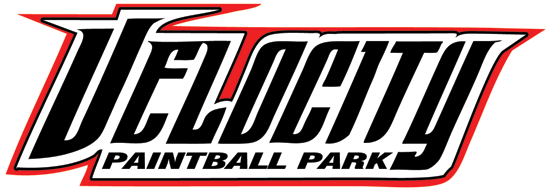TANK INSPECTION
#1 – Visually inspect the tank for cracks. You have to remove the tank cover to see the whole tank.
IS THE TANK CERTIFIED TO USE?
#2 – Check for DOT or ISO/UN numbers
HYDROSTATIC TEST DATE
#3 Look for the born on date or the date of the last Hydrotest
TANK DATES and LIFESPAN
- All tanks must be hydrotested every 5 years
- All tanks have a 15-year lifespan
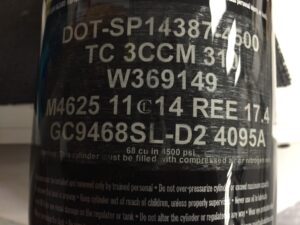
carbon fiber compressed air tank
Every carbon fiber wrapped bottle has a label on the side. Every metallic bottle has the pertinent information stamped into it near the top of the bottle.
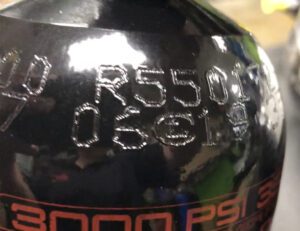
steel or aluminum compressed air tank
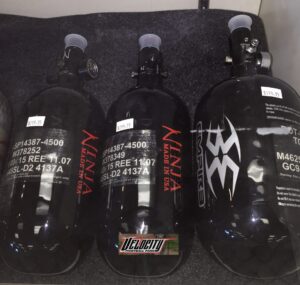
carbon fiber compressed air tanks
NUMBERS ON THE TANKS:
The DOT Number is the number that is given to a bottle lot to make it easily identifiable by the Department of Transportation.
To the right of the DOT Number is the Maximum Operating Pressure, in this instance it is 4500. This bottle is capable of holding 4500 PSI.
Below the DOT Number is the Canadian equivalent of the DOT Number and to the right of that is the pressure rating in BARs (each Bar is equivalent to 14.508 PSI, so 14.508 X 310 = 4497.48 PSI)
Below the serial numbers is the HYDRO DATE (or Born on Date). 12 @ 04 The M number signifies the MANUFACTURER.
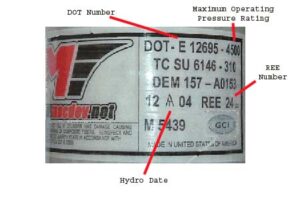
Below that is the bottles SERIAL NUMBERS. DEM 157 – A0153
Below the serial numbers is the HYDRO DATE (or Born on Date). 12 @ 04
The M number signifies the MANUFACTURER.
13ci Compressed Air Tanks – The myth is that tanks this size do not have to be hydrotested because they fall under the 2″ diameter and under 24″ in length. The 3AL specification cylinder re-qualification set forth in CFR49 ss180.205 requires that tanks must be hydrostatically tested and are only exempt from volumetric tests. Similar tanks that are marked 3E do not require hydrotesting.
NEED A HYDROTEST?
Velocity can help you out!
E-mail denise@velocitypb.com a picture of your tank label to make sure your tank meets the requirements.
HYDROTEST INSTRUCTIONS
- INCLUDE THIS FORM WITH YOUR TANK(s) when mailing.
- Make sure there is a pre-paid return ship label in the box as well.
- Let us know when you ship, so we can keep a lookout.
- Cost is $30 for each tank to be Hydrotested.
- We will send you an invoice/link when the tank is back from hydro.
- Please include a current phone number and email so we can reach you to let you know when your tank ships back to you.
- Payment for tanks ($30/each) will be taken with Shopify when the tank has passed the Hydrotest.
- Please remove the regulator before shipping. Only ship the tank or tanks.
- Please include the shipping label (no stamps accepted) for returning your tank(s). All shipping is covered by the sender.
